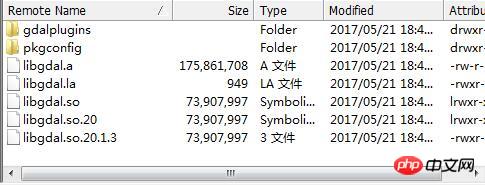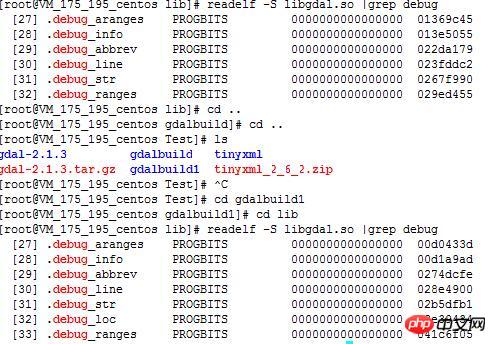 Operation and Maintenance
Operation and Maintenance
 Linux Operation and Maintenance
Linux Operation and Maintenance
 How to compile GDAL dynamic library with g++ in Linux environment
How to compile GDAL dynamic library with g++ in Linux environment
How to compile GDAL dynamic library with g++ in Linux environment
The following editor will bring you an articleLinuxHow to compile GDAL dynamic library using environment g++. The editor thinks it’s pretty good, so I’ll share it with you now and give it as a reference. Let’s follow the editor and take a look.
1. Compilation steps
Decompress the downloaded GDAL source program and switch to Unzip the directory.
tar -xzvf gdal-2.1.3.tar.gz cd gdal-2.1.3
GDAL can implement some custom configurations through configure, which can be viewed through the ./configure –h command. --prefix=path indicates the build directory after setting GDAL's make install, which contains the generated header files and dynamic libraries. Enter the following command:
./configure --prefix=/root/Test/gdalbuild
At this time, you can find that the GDALmake.opt file is newly generated in the directory, and the file is included in GNUmakefile for compilation. Enter the command:
make make install
After the compilation is completed, the generated dynamic library file will be in the set directory. The Include directory stores header files, the lib directory stores dynamic library files, and the bin directory stores executable files such as gdalinfo.

2. Note that
1) Note that this is generated in the directory you set instead of the default directory, you need to set the environment variable when calling, or copy it to the system's lib directory, or compile without setting the -prefix parameter.
2) The configure command can also be used to set the debug version or release version. You only need to add the --enable-debug parameter later to control it. It's off by default.
--enable-debug enable debugging (disabled by default)
But I found that there seems to be a problem with this description of GDAL. I compiled two versions with and without this parameter respectively:
With parameter --enable-debug:

Without parameters --enable-debug:

You can see that the release version according to the instructions is larger than the debug version. Generally speaking, the release version has smaller information than the debug version. According to this article "Check whether .so and executable files are debug compiled under Linux" to check whether they are debug compiled, it is found that both have debug information. Release The version has one less debug information than the debug version:

In this way, it is not clear which version is the debug version, and can only be left for future research.
The above is the detailed content of How to compile GDAL dynamic library with g++ in Linux environment. For more information, please follow other related articles on the PHP Chinese website!

Hot AI Tools

Undresser.AI Undress
AI-powered app for creating realistic nude photos

AI Clothes Remover
Online AI tool for removing clothes from photos.

Undress AI Tool
Undress images for free

Clothoff.io
AI clothes remover

Video Face Swap
Swap faces in any video effortlessly with our completely free AI face swap tool!

Hot Article

Hot Tools

Notepad++7.3.1
Easy-to-use and free code editor

SublimeText3 Chinese version
Chinese version, very easy to use

Zend Studio 13.0.1
Powerful PHP integrated development environment

Dreamweaver CS6
Visual web development tools

SublimeText3 Mac version
God-level code editing software (SublimeText3)

Hot Topics
 1664
1664
 14
14
 1423
1423
 52
52
 1317
1317
 25
25
 1268
1268
 29
29
 1242
1242
 24
24
 Linux Architecture: Unveiling the 5 Basic Components
Apr 20, 2025 am 12:04 AM
Linux Architecture: Unveiling the 5 Basic Components
Apr 20, 2025 am 12:04 AM
The five basic components of the Linux system are: 1. Kernel, 2. System library, 3. System utilities, 4. Graphical user interface, 5. Applications. The kernel manages hardware resources, the system library provides precompiled functions, system utilities are used for system management, the GUI provides visual interaction, and applications use these components to implement functions.
 How to check the warehouse address of git
Apr 17, 2025 pm 01:54 PM
How to check the warehouse address of git
Apr 17, 2025 pm 01:54 PM
To view the Git repository address, perform the following steps: 1. Open the command line and navigate to the repository directory; 2. Run the "git remote -v" command; 3. View the repository name in the output and its corresponding address.
 vscode Previous Next Shortcut Key
Apr 15, 2025 pm 10:51 PM
vscode Previous Next Shortcut Key
Apr 15, 2025 pm 10:51 PM
VS Code One-step/Next step shortcut key usage: One-step (backward): Windows/Linux: Ctrl ←; macOS: Cmd ←Next step (forward): Windows/Linux: Ctrl →; macOS: Cmd →
 How to run java code in notepad
Apr 16, 2025 pm 07:39 PM
How to run java code in notepad
Apr 16, 2025 pm 07:39 PM
Although Notepad cannot run Java code directly, it can be achieved by using other tools: using the command line compiler (javac) to generate a bytecode file (filename.class). Use the Java interpreter (java) to interpret bytecode, execute the code, and output the result.
 How to run sublime after writing the code
Apr 16, 2025 am 08:51 AM
How to run sublime after writing the code
Apr 16, 2025 am 08:51 AM
There are six ways to run code in Sublime: through hotkeys, menus, build systems, command lines, set default build systems, and custom build commands, and run individual files/projects by right-clicking on projects/files. The build system availability depends on the installation of Sublime Text.
 What is the main purpose of Linux?
Apr 16, 2025 am 12:19 AM
What is the main purpose of Linux?
Apr 16, 2025 am 12:19 AM
The main uses of Linux include: 1. Server operating system, 2. Embedded system, 3. Desktop operating system, 4. Development and testing environment. Linux excels in these areas, providing stability, security and efficient development tools.
 laravel installation code
Apr 18, 2025 pm 12:30 PM
laravel installation code
Apr 18, 2025 pm 12:30 PM
To install Laravel, follow these steps in sequence: Install Composer (for macOS/Linux and Windows) Install Laravel Installer Create a new project Start Service Access Application (URL: http://127.0.0.1:8000) Set up the database connection (if required)
 git software installation
Apr 17, 2025 am 11:57 AM
git software installation
Apr 17, 2025 am 11:57 AM
Installing Git software includes the following steps: Download the installation package and run the installation package to verify the installation configuration Git installation Git Bash (Windows only)



